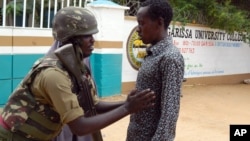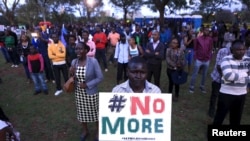Kenya has reopened Garissa University College, the scene of the single deadliest terrorist attack in East Africa since the 1998 U.S. embassy bombings.
Teachers and some students returned to the college Monday, nine months after gunmen rampaged through the eastern Kenyan school and killed 148 people, all but five of them students. Classes are set to resume next week.
The college was scheduled to reopen during the summer, but officials decided to move up the date last month when government officials and MPs visited the town.
Ethnic Somali politicians representing Garissa town told the government they were determined to reopen the only university in the region, said college principal Ahmed Osman Warfa.
He said the decision ultimately stemmed from a desire to move on.
"We were attacked, we are aggrieved, we are saddened but we have to move on. Counseling has been done, and life has to go on," he told VOA's Somali Service.
New students
The college had about 800 students at the time of the attack, but only 80 of those will be back next week to resume their education. They will be joined by about 170 new students, Warfa said.
Al-Shabab has carried out dozens of attacks in Kenya since Kenyan troops crossed the border to fight the group in 2011. Prior to last April, al-Shabab's deadliest attack was the 2013 assault on Nairobi's Westgate Mall that left 67 people dead.
Garissa, which sits about 150 kilometers from the Somali border, was considered a remote and safe area until the morning of April 2, 2015, when five gunmen stormed the campus and began to summon students out of dormitories.
Witnesses and officials said the attackers spared Muslims during the daylong assault while singling out and shooting Christians.
Somali President Hassan Sheikh Mohamud said the group's intention was to divide communities in Kenya along religious lines. But it appears they failed. When al-Shabab hijacked a bus in Kenya's Mandera district last month, the Muslims on board — in an unprecedented action — refused to be separated from the Christians. The gunmen let the bus and its passengers go.
No 'more attacks'
Warfa said he is not worried about another attack on the college.
"We don't expect any more attacks because we have enough security. We have a police force inside the university, we have 30 police officers and we are hoping they will be able to take care of all the security measures inside and outside the university," he said.
Four of the gunmen who stormed the campus that day were killed by security forces, while a fifth blew himself up with explosives. The government has since arrested five more men, all of them charged with conspiracy to commit a terrorist act.
However, two militants the Kenyan government named as the "masterminds" of the attack, Mohamed Kuno and Ahmed Iman, are still at large.
Kuno, also known as Dulyadayn, is the commander of al-Shabab forces in the Juba regions, while Iman is the head of al-Hijra, Shabab's Kenya branch. The government has offered rewards of $20,000 each for information leading to their capture.












